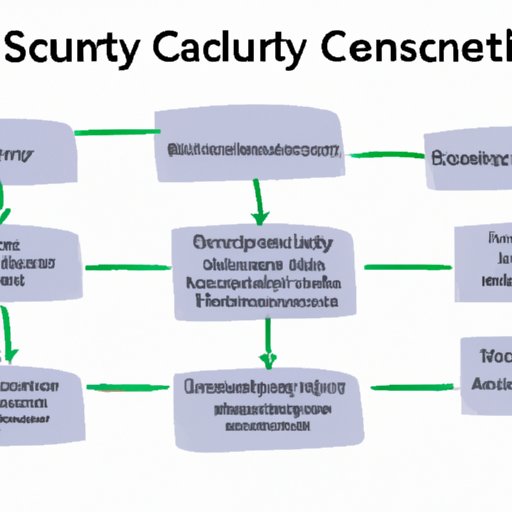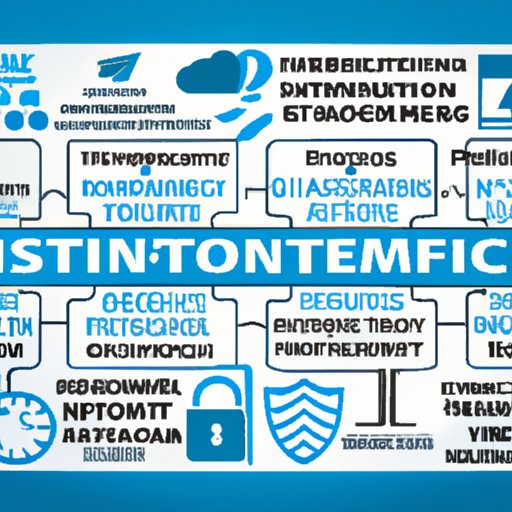Introduction
As technology continues to evolve, organizations are faced with new challenges when it comes to protecting their data, systems, and networks. Cybersecurity has become increasingly important in recent years, and organizations must take steps to ensure that their information and assets are adequately protected. One way to do this is by implementing a cybersecurity framework.
What is a Cybersecurity Framework?
A cybersecurity framework is a set of guidelines, policies, and procedures that organizations can use to help protect their data and systems from cyber threats. It provides a comprehensive approach to managing and mitigating risks associated with cyberattacks. The framework typically consists of various components such as risk management, access control, network and system security, and incident response. By implementing a cybersecurity framework, organizations can better protect their data, systems, and networks.
Benefits of Adopting a Cybersecurity Framework
Adopting a cybersecurity framework offers numerous benefits for organizations. It helps organizations identify and address security gaps in their systems and networks, as well as create an environment where security is prioritized. Additionally, it allows organizations to develop a more comprehensive security strategy that includes both technical and non-technical measures. Finally, it helps organizations prepare for and respond to potential cyberthreats.

An Overview of Popular Cybersecurity Frameworks
There are several popular cybersecurity frameworks available for organizations to choose from. Each framework has its own set of features, benefits, and drawbacks, so it’s important to understand which one is most suitable for your organization’s needs. Here are some of the most popular cybersecurity frameworks:
NIST Cybersecurity Framework
The National Institute of Standards and Technology (NIST) Cybersecurity Framework is a voluntary framework designed to help organizations manage their cybersecurity risks. It consists of five core functions—Identify, Protect, Detect, Respond, and Recover—which are supported by underlying categories such as asset management, governance, and risk assessment. Additionally, it includes guidance on how to implement the framework and measure its effectiveness.
ISO/IEC 27001
The International Organization for Standardization (ISO) and the International Electrotechnical Commission (IEC) have developed the ISO/IEC 27001 standard for information security management. This standard is based on a risk management approach and provides organizations with a set of processes, procedures, and controls that can be used to assess, manage, and reduce risks associated with the use of information systems. Additionally, it provides guidance on how to develop and maintain an effective information security management system.
Other Popular Cybersecurity Frameworks
In addition to the NIST Cybersecurity Framework and ISO/IEC 27001, there are several other popular cybersecurity frameworks available. These include the Center for Internet Security (CIS) Controls, the Control Objectives for Information and Related Technology (COBIT), and the Payment Card Industry Data Security Standard (PCI DSS). Each of these frameworks has its own set of features, benefits, and drawbacks, so it’s important to understand which one is most suitable for your organization’s needs.

Understanding the Components of a Cybersecurity Framework
A cybersecurity framework typically consists of several components, each of which plays an important role in helping organizations manage and mitigate their cybersecurity risks. Here are some of the most important components of a cybersecurity framework:
Risk Management
Risk management is a critical component of any cybersecurity framework. It involves assessing the risks associated with the use of information systems, developing strategies to manage those risks, and implementing controls to reduce the likelihood of a breach or attack. Additionally, it involves monitoring the effectiveness of those controls and making adjustments as necessary.
Access Control
Access control is another important component of a cybersecurity framework. It involves establishing rules and procedures for granting and revoking access to systems, networks, and data. Additionally, it involves monitoring user activity and enforcing authentication and authorization requirements.
Network and System Security
Network and system security are also essential components of a cybersecurity framework. It involves implementing technical measures to protect networks and systems from malicious actors, such as firewalls, antivirus software, and intrusion detection systems. Additionally, it involves regularly patching systems and applications and monitoring network traffic for anomalous activity.
Incident Response
Incident response is the final component of a cybersecurity framework. It involves developing and implementing procedures for responding to security incidents, such as breaches and attacks. Additionally, it involves conducting post-incident reviews to assess the effectiveness of the response and make improvements as necessary.
How to Select the Right Cybersecurity Framework for Your Organization
Selecting the right cybersecurity framework for your organization can be a challenging task. Here are some tips for selecting the right framework for your organization:
Assessing Your Current Security Practices
The first step in selecting the right cybersecurity framework is to assess your current security practices. This will help you identify areas where additional security measures may be needed. Additionally, it will help you determine the type of framework that would best meet your organization’s needs.
Identifying Your Goals and Objectives
Once you’ve assessed your current security practices, the next step is to identify your goals and objectives. This will help you determine which framework is best suited to meet those objectives. For example, if your goal is to improve incident response capabilities, then a framework that focuses on incident response would be a good choice.
Evaluating the Available Options
Once you’ve identified your goals and objectives, the next step is to evaluate the available options. This will involve researching the different frameworks and comparing them based on features, cost, complexity, and other factors. Additionally, it’s important to consider the level of support that the framework provider offers, as this can make a big difference in the long run.
Implementing and Maintaining a Cybersecurity Framework
Once you’ve selected the right cybersecurity framework for your organization, the next step is to implement and maintain it. Implementing a cybersecurity framework involves developing policies and procedures, training employees, and monitoring systems. Additionally, it involves periodically reviewing and updating the framework to ensure that it remains effective.
Developing Policies and Procedures
Developing policies and procedures is an essential part of implementing a cybersecurity framework. These policies and procedures should outline the roles, responsibilities, and expectations of all stakeholders involved in the process. Additionally, they should include detailed instructions for responding to security incidents and implementing security controls.
Training Employees
Training employees is another important step in implementing a cybersecurity framework. This involves educating employees about the framework and how to use it effectively. Additionally, it involves providing ongoing training to ensure that employees remain up to date on the latest security trends and best practices.
Monitoring Systems
Monitoring systems is also an important part of implementing a cybersecurity framework. This involves tracking activities on networks and systems and looking for suspicious behavior. Additionally, it involves regularly scanning systems for vulnerabilities and patching any that are found.

Best Practices for Developing a Cybersecurity Framework
Developing a cybersecurity framework is a complex process, but there are certain best practices that can help make it easier. Here are some best practices for developing a cybersecurity framework:
Establishing Roles and Responsibilities
Establishing roles and responsibilities is an important step in developing a cybersecurity framework. This involves identifying who is responsible for specific tasks and ensuring that those tasks are completed in a timely and efficient manner. Additionally, it involves clearly defining the roles and responsibilities of all stakeholders involved in the process.
Prioritizing Resources
Prioritizing resources is another important step in developing a cybersecurity framework. This involves determining which resources need to be allocated to specific tasks and ensuring that those resources are used efficiently and effectively. Additionally, it involves regularly evaluating the allocation of resources and making changes as necessary.
Establishing Appropriate Controls
Establishing appropriate controls is also an important step in developing a cybersecurity framework. This involves identifying the types of controls needed to protect systems, networks, and data and implementing those controls in a timely and efficient manner. Additionally, it involves regularly evaluating the effectiveness of those controls and making changes as needed.
Conclusion
Cybersecurity is an increasingly important issue for organizations of all sizes. A cybersecurity framework can help organizations protect their data, systems, and networks from cyberthreats. There are several popular cybersecurity frameworks available, each of which has its own set of features, benefits, and drawbacks. Additionally, there are several components of a cybersecurity framework, such as risk management, access control, network and system security, and incident response. When selecting a cybersecurity framework, it’s important to assess your current security practices, identify your goals and objectives, and evaluate the available options. Additionally, it’s important to implement and maintain the framework in order to ensure that it remains effective. Finally, there are several best practices for developing a cybersecurity framework, such as establishing roles and responsibilities, prioritizing resources, and establishing appropriate controls.
(Note: Is this article not meeting your expectations? Do you have knowledge or insights to share? Unlock new opportunities and expand your reach by joining our authors team. Click Registration to join us and share your expertise with our readers.)
